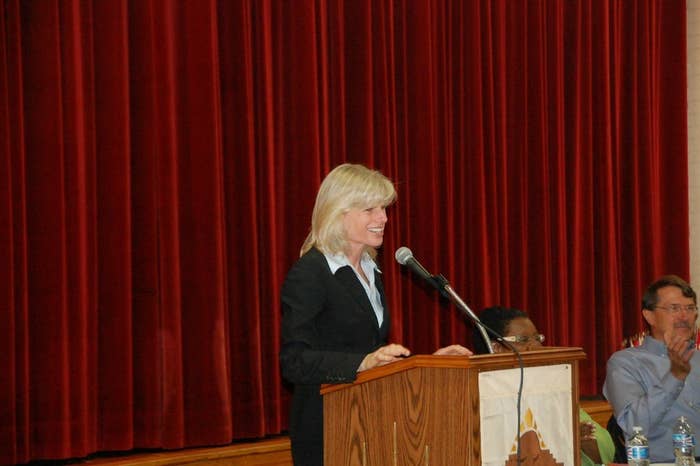
More sections of Wisconsin Democratic gubernatorial candidate Mary Burke's rural communities plan appear to be copied directly from a variety of sources.
The copied text includes failed 2010 Nevada gubernatorial candidate Rory Reid, a newspaper article, and a Wisconsin school press release.
As in previous instances, some of Burke's plan includes links to sources in plan's footnotes, but Burke's plan doesn't indicate the words are taken directly from the source.
BuzzFeed News previously reported Burke economic plan "Invest for Success" took almost word-for-word portions of the jobs plans of Cammack, part of Delaware Gov. Jack Markell's 2008 plan, part of now-Virginia Governor Terry McAuliffe's plan from his failed-2009 bid, and failed-2012 Indiana gubernatorial candidate John Gregg.
BuzzFeed News also previously reported part of Burke's veterans and rural communities plans copied text directly from academic journals and reports, a local newspaper column, and failed 2010 Utah gubernatorial candidate Peter Corroon.
In a local radio interview, Burke dismissed the copied text as "as "very small" and "extremely limited" passages.
"I am going to draw on best practices and innovative ideas that are working in other parts of the country," she said. "But these plans are very in depth and what has been identified are very small passages, scattered throughout that, that have, uh, maybe been used in other plans that this consultant developed."
"This is something that is extremely limited and the main bulk of this work is work that I have been deeply involved with. And there not ideas in those plans unless I thought that they were great ideas for Wisconsin on how we're going to move our economy forward."
Here's 2010 gubernatorial candidate Rory Reid's platform on education:
Reward teachers and principals who move to underserved or underperforming schools. Most states offer financial incentives for teachers in subject-areas with shortages, such as math and science, or in underserved schools.
And here's Burke:
Rewarding successful educators who choose to move to underserved or underperforming schools in rural areas. Most states offer financial incentives for educators in subject-area shortages – such as math and science – or underserved schools, particularly in smaller districts
or rural areas.
Here's the work where the source is cited, but little to no text is changed:
Here's a 2010 Wisconsin State Journal article:
Many of Wisconsin's regional health systems have set up telemedicine networks.
Gundersen Lutheran in La Crosse, Luther Midelfort in Eau Claire, Aspirus in Wausau, Bellin Health in Green Bay and Aurora Health Care in Milwaukee are among the systems with video connections in rural areas.
Marshfield Clinic, which serves most of northern Wisconsin, was one of the first to implement telemedicine, in 1997, in two small towns: Ladysmith and Park Falls.
The multisite clinic now makes doctors in 45 specialties available by two-way, broadband video connection at 60 locations, said Nina Antoniotti, Marshfield Clinic's telehealth director.
And here's Burke:
Many of Wisconsin's regional health systems have already set up telemedicine networks – some with the help of federal telemedicine grant funding. Gundersen Lutheran in La Crosse, Luther Midelfort in Eau Claire, Aspirus in Wausau, Bellin Health in Green Bay and Aurora Health Care in Milwaukee are among the systems with video connections in rural areas. Marshfield Clinic, which serves most of northern Wisconsin, was a telemedicine pioneer back in 1997. The clinic now makes doctors in 45 specialties available by two-way, broadband video connection at 60 locations.
Here's a press release from the University of Wisconsin-Extension:
On Oct. 1, 2013, with funds from a Federal Economic Development Association (EDA) grant, the University of Wisconsin-Extension began a statewide assessment of Wisconsin's food processing and manufacturing support infrastructure. This assessment will identify current assets, gaps, and industry needs;
And here's Burke:
For example, last year, with funds from a federal Economic Development Association (EDA) grant, the University of Wisconsin-Extension undertook an assessment of our state's food processing and manufacturing support infrastructure in order to identify assets, gaps, and industry- wide needs.
Burke's rural plan also includes copied passages that also appeared in her jobs plan:
Here's the copied text from Cammack that appears in her rural communities plan:
Expanding intern programs to provide help to small farmers and also give students direct agricultural education and experience.
And here's Burke:
Expanding intern programs to provide help to small farmers and also give students direct agricultural education and experience.
Here's the copied text Cammack that also appears in her jobs plans:
Here's Cammack:
Helping farmers with succession planning by developing new programs that match new farmers with those retiring who have no successors interested in continuing the family farm.
And here's Burke:
Developing new programs that match new farmers with those retiring who have no successors interested in continuing the family farm.
Here's Cammack:
Supporting the development of public-private partnerships by working to match small farmers with business professionals to help farmers improve management, develop new markets plans and improve use of risk management tools and risk reduction strategies.
And here's Burke:
Supporting the development of public- private partnerships by working to match small farmers with business professionals to help farmers improve management, develop new markets plans and improve use of risk management tools and risk- reduction strategies.
